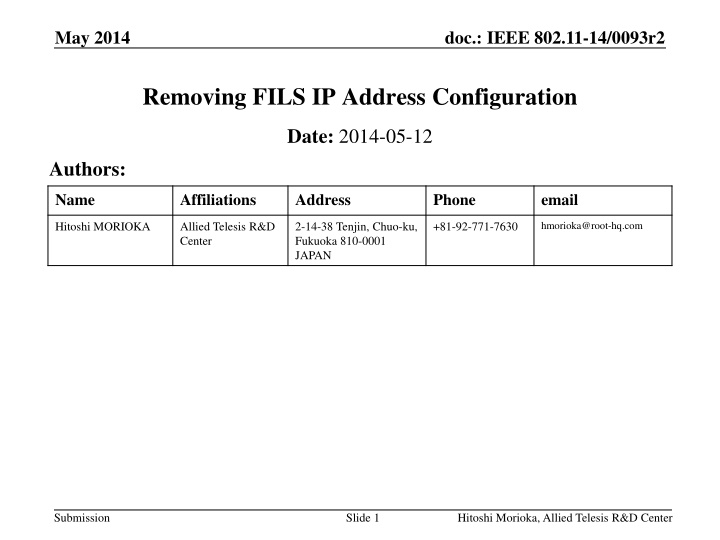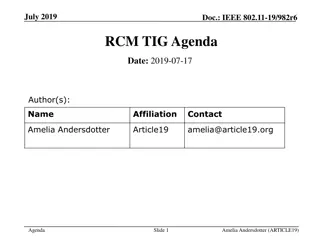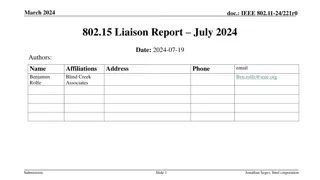Removal of FILS IP Address Configuration in IEEE 802.11-14/0093r2
This document details the rationale behind the proposal to remove FILS IP Address Configuration in IEEE 802.11-14/0093r2. The author, Hitoshi Morioka, explains that the need for this configuration is redundant due to the HLP encapsulation's ability to support all required functions. By eliminating certain clauses and modifying related sections, confusion will be avoided while maintaining efficient IP address assignment processes. Various slides provide insights into the CID comments, benefits, and performance improvements associated with this change.
Download Presentation

Please find below an Image/Link to download the presentation.
The content on the website is provided AS IS for your information and personal use only. It may not be sold, licensed, or shared on other websites without obtaining consent from the author.If you encounter any issues during the download, it is possible that the publisher has removed the file from their server.
You are allowed to download the files provided on this website for personal or commercial use, subject to the condition that they are used lawfully. All files are the property of their respective owners.
The content on the website is provided AS IS for your information and personal use only. It may not be sold, licensed, or shared on other websites without obtaining consent from the author.
E N D
Presentation Transcript
May 2014 doc.: IEEE 802.11-14/0093r2 Removing FILS IP Address Configuration Date: 2014-05-12 Authors: Name Affiliations Address Phone email hmorioka@root-hq.com Hitoshi MORIOKA Allied Telesis R&D Center 2-14-38 Tenjin, Chuo-ku, Fukuoka 810-0001 JAPAN +81-92-771-7630 Submission Slide 1 Hitoshi Morioka, Allied Telesis R&D Center
May 2014 doc.: IEEE 802.11-14/0093r2 Abstract This document describes the reason why I intend to remove the FILS IP Address Configuration. The related CIDs are 4502 and 4429. Submission Slide 2 Hitoshi Morioka, Allied Telesis R&D Center
May 2014 doc.: IEEE 802.11-14/0093r2 CID4502 Comment FILS IP Address Configuration is not required. Because the HLP encapsulation can perform all functions supported by the FILS IP Address Configuration. The duplication will make confusion. Proposed Change Remove clause 10.44.3.2, 8.4.2.181 and 8.6.24. And modify rerated part in other clauses. Submission Slide 3 Hitoshi Morioka, Allied Telesis R&D Center
May 2014 doc.: IEEE 802.11-14/0093r2 FILS IP Address Configuration FILS specific IP address configuration mechanism. No IP address continuity between APs. Each AP has its own IP address pool. Existing WLAN network has IP address continuity in a ESS. The IP address of the non-AP STA is assigned by the AP, not by the DHCP server. The request and response are carried by Association/Reassociation frames. The information carried by the mechanism is IP address and netmask of non-AP STA IP address and MAC address of the gateway IP address (and MAC address if it s in the same network) of the DNS server Submission Slide 4 Hitoshi Morioka, Allied Telesis R&D Center
May 2014 doc.: IEEE 802.11-14/0093r2 Benefit of FILS IP Address Configuration FILS IP Address Configuration is used to reduce the overhead caused by using the DHCP for the IP address assignment. Submission Slide 5 Hitoshi Morioka, Allied Telesis R&D Center
May 2014 doc.: IEEE 802.11-14/0093r2 CID4429 Comment what overhead is reduced? It looks just a personal opinion and meaningless. Proposed Change Remove the sentence "FILS IP Address Configuration is used to recude the overhead caused by using the DHCP for tha IP address assignment." Submission Slide 6 Hitoshi Morioka, Allied Telesis R&D Center
May 2014 doc.: IEEE 802.11-14/0093r2 Performance FILS IP Address Configuration Configuration can be done in 1-roundtrip between STA and AP. IP address assignment is fast because the IP address assignment function is in the AP. DHCP in HLP encapsulation Configuration can be done in 1-roundtrip between STA and AP with RCO. IP address assignment can be fast (equivalent to FILS IP Address Configuration) with the DHCP server located in the AP. Submission Slide 7 Hitoshi Morioka, Allied Telesis R&D Center
May 2014 doc.: IEEE 802.11-14/0093r2 Configuration Parameters FILS IP Address Configuration IP address and netmask of the STA IP address and MAC address of the gateway IP address (and MAC address if it s in the same network) of the DNS server DHCP in HLP encapsulation IP address and netmask of the STA IP address of the gateway IP address of the DNS servers And any other DHCP options Gratuitous ARP in HLP encapsulation MAC address of the gateway MAC address of any node in the same network, not limited to DNS servers. Submission Slide 8 Hitoshi Morioka, Allied Telesis R&D Center
May 2014 doc.: IEEE 802.11-14/0093r2 Sequence FILS IP Address Configuration HLP encapsulation STA AP STA AP Association Request Association Request FILS IP Address Request DHCPDISCOVER w/RCO Association Response Association Response FILS IP Address Rsponse DHCPACK w/RCO Gratuitous ARP Submission Slide 9 Hitoshi Morioka, Allied Telesis R&D Center
May 2014 doc.: IEEE 802.11-14/0093r2 Operation (single AP) FILS IP Address Configuration HLP encapsulation Pool Pool Pool FILS DHCP DHCP AP AP ai non-ai STA ai non-ai STA STA STA Submission Slide 10 Hitoshi Morioka, Allied Telesis R&D Center
May 2014 doc.: IEEE 802.11-14/0093r2 Existing Typical WLAN Network DHCP Server AP AP AP AP AP AP Consider to replace the APs to ai-capable APs. Submission Slide 11 Hitoshi Morioka, Allied Telesis R&D Center
May 2014 doc.: IEEE 802.11-14/0093r2 Replacing with HLP encapsulation AP DHCP Server ai AP ai AP non-ai AP non-ai AP non-ai AP non-ai AP Just replace. Mixture of ai APs and non-ai APs is not a matter. Submission Slide 12 Hitoshi Morioka, Allied Telesis R&D Center
May 2014 doc.: IEEE 802.11-14/0093r2 Replacing with FILS IP Address Configuration AP IP address pool may be modified. DHCP server must remain to support non-ai AP non-ai STA DHCP Server Assign new IP address pool. ai AP Pool non-ai AP non-ai AP non-ai AP non-ai AP non-ai AP If the operator assumes 100 STAs connect to the network, the operator should assign at least 100 IP addresses to each IP address pool. DHCP server must remain to support non-ai STA DHCP Server Manage the IP address pools of all APs and DHCP server. ai AP Pool ai AP Pool ai AP Pool ai AP Pool ai AP Pool ai AP Pool Submission Slide 13 Hitoshi Morioka, Allied Telesis R&D Center
May 2014 doc.: IEEE 802.11-14/0093r2 Conclusion I could not find any technical benefits of FILS IP Address Configuration. I propose to remove FILS IP Address Configuration from the draft. Remove clause 10.44.3.2, 8.4.2.181 and 8.6.24. And modify related part in other clauses Submission Slide 14 Hitoshi Morioka, Allied Telesis R&D Center
May 2014 doc.: IEEE 802.11-14/0093r2 Questions & Comments Submission Slide 15 Hitoshi Morioka, Allied Telesis R&D Center
May 2014 doc.: IEEE 802.11-14/0093r2 Motion Move to remove FILS IP Address Configuration from TGai draft. Moved: Seconded: Result (Y/N/A): Submission Slide 16 Hitoshi Morioka, Allied Telesis R&D Center
May 2014 doc.: IEEE 802.11-14/0093r2 IPv6 IPv6 specification has autoconfiguration mechanisms. We should use these mechanisms, because Both ai and non-ai devices (including wired devices) are attached to the same network. Non-ai devices use IPv6 autoconfiguration including DAD. How to avoid conflict? IPv6 specification is still improving. How can we guarantee that ai specification never confilict with IPv6 specification in the future? HLP encapsulation can carry any higher layer packets, such as RA and DHCPv6. Submission Slide 17 Hitoshi Morioka, Allied Telesis R&D Center
May 2014 doc.: IEEE 802.11-14/0093r2 Implementation FILS IP Address Configuration New IP address configuration function must be implemented from scratch for both server and client. HLP encapsulation Modify existing DHCP client. DHCP server modification will not be required if RCO is already implemented or RCO is not used. Or, new ai-optimized DHCP client and server can be implemented from scratch as same as FILS IP Address Configuration if you want. I think it s not good way. Submission Slide 18 Hitoshi Morioka, Allied Telesis R&D Center






















